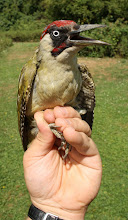No, not my behavior, or my brothers (for once)! It's the time of year when we start seeing good numbers of juveniles from the early breeders.
SSNR 30/05/11: 21 birds of 8 species (retraps in brackets)
Great Tit 9 (0) - including 6 juveniles
Whitethroat 4 (1) - the retrap being first ringed as an adult June 2010.
Grasshopper Warbler 1 (0) - the 5th this year for this site and the first female
Blackcap 1 (0) - only the third of this species for the site
Dunnock 0 (2)
Chiff Chaff 1 (0)
Sedge Warbler 1 (0)
Great Spotted Woodpecker 0 (1) - A regularly caught male.
SSNR yesterday 04/06/11: 55 birds of 11 species (retraps in brackets)
Blue Tit 4 (3) - all the new birds were juveniles
Great Tit 4 (0) - including 3 juveniles
Whitethroat 6 (3) - one of the retraps being from June 2010
Chaffinch 9 (1) - including 6 juveniles
Goldfinch 7 (2) - including 2 juveniles
Garden Warbler 3 (0) - 2 males and a female (NEW FOR SITE)
Grasshopper Warbler 0 (2) - a pair
Willow Warbler 1 (0) - the first adult caught on site
Blackcap 8 (0) - mostly adult males except 1 adult female and one juvenile
Dunnock 0 (1) - first ringed on 3rd March 2011
Sedge Warbler 0 (1) - a retrap from May 2011
This is not typical of visits to SSNR and it came as a very welcome surprise. I suspect there are a few reasons for this:
1. weather - overcast first thing (lifting but not completely later on) and wind from the east ('light' to start with increasing to 'far too' by the end of the session). Normal = windy and from the west. Perhaps this was partially responsible for catching a lot of blackcaps (rarely ringed here) and the Garden Warblers (where did they come from?!?).

Above: Garden Warbler
2. I've not ringed at this time of year here with a feeding station. Without this, the catch would consist mainly of Warblers.
3. Juveniles - it's that time of year. Blackbirds, Robins, Dunnocks, Whitethroats, Blue Tits, Great Tits, Song Thrushes, Chaffinches, Starlings, Blackcaps - I have seen fledged young of all these species around Bedfordshire. Some examples coming up (all juveniles):

Above: Great Tit

Above: Blue Tit (taken at Priory Country Park).

Above: Robin (taken at Priory Country Park - no juvenile Robins have been caught so far at SSNR).

Above: Blackcap

Above: Goldfinch

Above: Chaffinch

















































